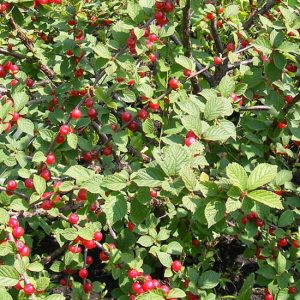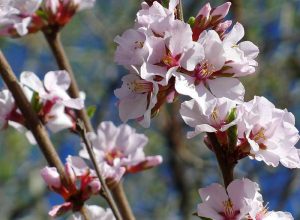Nanchino cherry – Prunus tomentosa


Of the same species as the common cherry, these species of prunus for now is only known by botanists and enthusiasts. Big shrub or small tree, hardwood, the Nanchino cherry grows spontaneously like our wild namesake (prunus avium) in the valleys from Japan to China and as far as the Himalayan slopes.
Of great ornamental effect, if not educated differently and positioned isolated, it tends to grow with several trunks reaching a height of about 3/5 meters and equally in diameter; if grown with a single trunk, if born in competition with other essences, it’s easy to find specimens even as high as ten meters. The pretty light green leaves, elliptical with a heavily jagged border and marked leaf stalks confer to the plant a pleasant appearance that shines through when the small red fruit appears. A very rustic essence, it stands very low wintery temperatures, it survives temperatures over -20°C, it loves the sun without which, apart from not flowering, it would produce a weak and poor vegetation; it’s very resistant to drought.
When becoming an adult, the fine bark of the trunk becomes a shiny reddish-brown, as years go by, it tends to flake, making the plant pleasant even in the dead season.
Other very important feature is its strength against strong winds: in its areas of origin, the Prunus Tomentosa is frequently used to form windbreak barriers.
TERRAIN
It prefers soils that tend to be acid, soft and well drained, but it vegetates well in those that are with limestones and that are loamy. In limestone soils, with a high ph, the plant tends to suffer due to iron chlorosis, showing this with a typical yellow colouring of the leaves.
FLORA AND FRUITS
At the start of spring, before the leaves appear, the Nanchino cherry is filled with several pink buds that, by blossoming, change colour becoming beautiful flowers with five petals that are almost white and that are spaced between each other and in the middle several pistils that make the plant become a lovely splash of colour.
From the flowers as many fruit appear, a bit smaller than the common cherries, with a very short stem, that at the beginning of the summer, when they ripen, colour all the branches red. The flowers are hermaphrodites, they have both male and female organs, even though, to produce more fruit, it’s best to plant at least two specimens next to each other to encourage cross pollination.
The flowers are very melliferous and, from the first pollen, the bees produce a very delicate honey.
If pollinated well, a plant of only a few years can already produce many fruit. The plants that are educated with a high stem, when the fruit ripen, attract many birds.
USE AND HEALTH PROPERTIES
With a pleasant sweet and sour taste, the numerous fruit, eaten as soon as picked, a very refreshing, but they are mostly transformed into marmalades and juices.
The well ripened fruit are ideal to alleviate bronchial problems and cough, have astringent and antibiotic power, they are also useful to cure gout.
Like all seeds of fruits from plants belonging to the rose tree family, to which the prunus genre also belongs, the Nanchino cherry seed contains a substance, amygdalin, that can release cyanide acid that is a powerful poison. Luckily, the amount is so small that to have an effect you would have to eat a huge amount of seeds.
Though, it’s to be said that, infinitesimal doses present not only are not harmful, but stimulate breathing and improve digestion. We also remind you that, the seed of the common apricot (botanic name: prunus armeniaca) contains the same substance, and is also present in the bitter almond, that is used though to make the typical biscuit Amaretto. The more the seed is bitter, the higher the amount of poison, but anyway, as we said, to have an effect you would have to eat a huge amount.
PRUNING AND CULTIVATION
Only aesthetic and restraining pruning is necessary, it’s good to know that the flower buds appear on the branches of the year before, so the pollen born from radical cuts, will bear fruit the following year.
A plant that is very resistant to drought, watering is only necessary for the engraftment, therefore only in case of extreme drought.
It’s also best to manure only when planting with an intake of a very mature organic substance, after, even in poor soils, the Nanchino cherry will find the necessary substances by itself.
Like all cherries, it can be attacked by aphids, especially in spring, and from the cherry fly, that lays its eggs in the fruit from where the typical maggot is born. Another pathogen of fungal origin, very common, but that rarely is injurious for the plant’s health, is the corineus, that shows on the leaves with small reddish marks that dry out and leave a hole and, on the branches, causing small lesions from which a rubbery substance comes out that, when in contact with oxygen, hardens.
